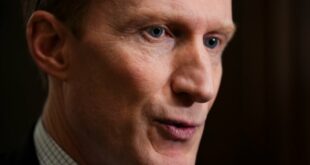Aviation experts suggest the company and its manufacturing practices need close scrutiny

Toronto resident Chris Moore, whose daughter Danielle was killed in the Ethiopian Airlines crash of a Boeing 737 Max in 2019, said he wasn't surprised when he heard of the mid-air blowout on a Boeing 737 Max 9 jet earlier this month.
"It's just a matter of time before something like this would happen," said Moore. "[Boeing says] that safety is No. 1, but they don't walk the talk."
Part of that talk included a stop at the U.S. Capitol on Wednesday from Boeing's CEO Dave Calhoun, who met with several senators. Calhoun said he was there "in the spirit of transparency" to "answer all their questions."
The meeting was prompted by a letter written to Calhoun earlier this month by U.S. Sens. Ed Markey, J.D. Vance and Peter Welch. The senators, who are members of the Senate commerce, science and transportation committee, wrote a letter after the latest blowout saying they were concerned about "a systemic issue with Boeing's capabilities to manufacture safe airplanes."
Calhoun's meeting comes as Boeing finds itself once again under investigation by the Federal Aviation Administration (FAA) and National Transportation Safety Board (NTSB).

The investigators are trying to find out why a panel tore off one of Boeing's planes during Alaska Airlines Flight 1282, as the aircraft flew 4,800 metres above Oregon. Known as a door plug, the panel was covering a spot left for an emergency door.
Officials say there were no serious injuries among the 171 passengers and six crew members on board at the time, though the interior of the plane suffered extensive damage.
2018, 2019 crashes killed 346 people
That blowout has put the airplane manufacturer back on the defensive after years of trying to regain confidence following Max accidents in 2018 and 2019. Those involved a Lion Air plane crash in Indonesia that killed all 189 people on board and the Ethiopian Airlines crash, which killed 157 people.
Those crashes led to an 18-month investigation by a U.S. House of Representatives panel that found in September 2020 that Boeing had failed in its design and development of the Max, as well as its transparency with the FAA. The House also found that the FAA failed in oversight and certification.
A month later, the FAA lifted the grounding order of the 737 Max to fly again. Yet some problems persisted, including electrical problems in April 2021 that led to dozens of the planes being suspended from service. In 2023, the airline manufacturer also dealt with some supply quality problems, and that Decemember it urged airlines to inspect newer 737 Max airplanes for a possible loose bolt in the rudder control system.
In January 2023, the FAA announced that it had assembled a group of experts, including people from the FAA, NASA, airlines and aviation manufacturers. to examine safety practices at Boeing. Their report is due next month.
Since the latest mid-air blowout, all Boeing Max 9 planes have been grounded. Meanwhile, the FAA is conducting an audit involving the jet's production line and its suppliers "to evaluate Boeing's compliance with its approved quality procedures."
Earlier this week, in an interview with NBC News, Alaska Airlines CEO Ben Minicucci said the airline's inspection of its Boeing 737 Max 9 planes revealed that "many" of the aircraft had loose bolts. Days after the incident, United Airlines also reported that it found loose bolts and other "installation issues" on a part of some Boeing 737 Max 9s.
'A final warning' for Boeing?
"I'm disappointed that… this keeps happening at Boeing. This isn't new," said Scott Kirby, CEO of United, in an interview Tuesday on CNBC.
"We need Boeing to succeed. But they've been having these consistent manufacturing challenges. They need to take action here."

Why Boeing’s 737 Max 9 problems didn’t surprise this whistleblower
15 days ago
A former Boeing senior manager who flagged problems with Max series jets before fatal crashes in 2018 and 2019 wasn’t surprised by the recent malfunction. Ed Pierson talks to The National’s Adrienne Arsenault about how it could’ve happened and what needs to be done to prevent more problems.
In Washington, however, Boeing's CEO told reporters on Wednesday that the company doesn't "put planes in the air that we don't have 100 per cent confidence in."
Stan Deal, president and CEO of Boeing Commercial Airplanes, also said Boeing is taking action "on a comprehensive plan to bring these airplanes safely back to service and to improve our quality and delivery performance."
But to Moore, it's all just words.
"It doesn't mean anything to me right now. I think the the proof is in the pudding."
Aviation safety consultant Robert Ditchey said part of the problem is that Boeing no longer oversees the entire manufacturing process. It subcontracts manufacturing to companies such as Spirit AeroSystem to build some components. Subcontractors in turn offshore some of their work, he said.
That means Boeing may not know the process by which some of the materials on the plane are constructed, Ditchey said.
"Is the alloy really the alloy that Boeing wants? Or is something else? How good is that alloy? Is it uniform? Is it proper thickness? That's critical in an aircraft structure," he said in an interview from California.
"So the point is [Boeing has] absolutely no control over that."
Dickey also has questions about who was responsible for the design of the door plug involved in the blowout.
"I've been around Boeing structures for years and years. It doesn't look like a Boeing product," he said.
"So who designed it? Who engineered it?"
John Strickland, a U.K.-based aviation consultant, said leaders he has spoken to in the airline industry have expressed the need for a culture change at Boeing that extends to personnel changes at senior levels.
"The warning bells have truly sounded and they must be heeded," he said.
Strickland said it was "still surprising" that the mid-air blow out occurred as Boeing has come back from "an incredibly challenging, questioning of confidence" in the company, not only by the traveling public but by airline customers.
"I would say in some ways it's like a final warning."
In a column for the Seattle Times, Andy Pasztor, who covered aviation safety for The Wall Street Journal for nearly three decades and is currently writing a book on airline safety, wrote that investigations of the recent incident must expand far beyond safety practices and manufacturing controls.
"Investigators should scrutinize persistent company failures over the past four decades to become more transparent and law-abiding," he wrote.
Boeing's leaders, he wrote, have not fully embraced lessons learned "from previous blunders.
"At this point, regulators, lawmakers and passengers should question what in Boeing's corporate DNA has mired it in severe quality-control and legal troubles."

As Boeing tries to figure out what caused a mid-air blowout on one of its Boeing 737 Max 9 aircraft last week, one expert says the company is a shell of what it once was. John Goglia, an aviation safety consultant who used to work for the U.S. National Transportation Safety Board, spoke to As It Happens host Nil Köks
Former NTSB member John Goglia told CBC's As It Happens earlier this month said the panel blowout was just "another black eye for Boeing." He said believed that Boeing has lost touch with its products, especially at the higher levels of the company.
"Boeing is not the same Boeing as I grew up with," he said.
Goglia said if he was in charge of Boeing, he'd hire at least 100 new inspectors to get the focus back on quality.
"They've got to get the products on firm ground," he said. "Every few months there seems to be a new revelation about issues."
ABOUT THE AUTHOR

Senior Reporter
Mark Gollom is a Toronto-based reporter with CBC News. He covers Canadian and U.S. politics and current affairs.
With files from Reuters

Add some “good” to your morning and evening.
Start the day smarter. Get the CBC News Morning Brief, the essential news you need delivered to your inbox.
The next issue of CBC News Morning Brief will soon be in your inbox.
Discover all CBC newsletters in the Subscription Centre.
*****
Credit belongs to : www.cbc.ca
 Atin Ito First Filipino Community Newspaper in Ontario
Atin Ito First Filipino Community Newspaper in Ontario






